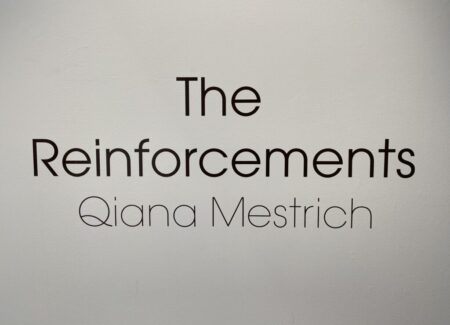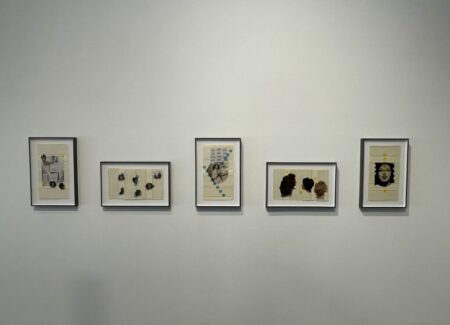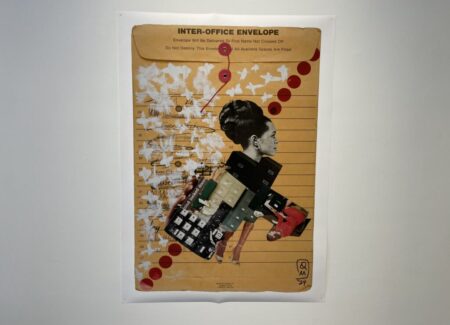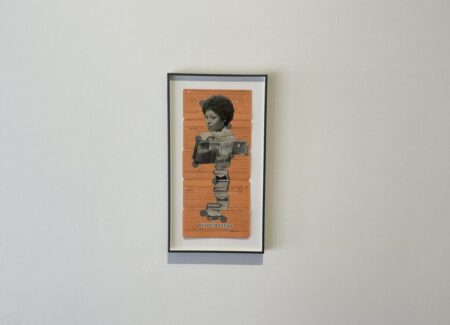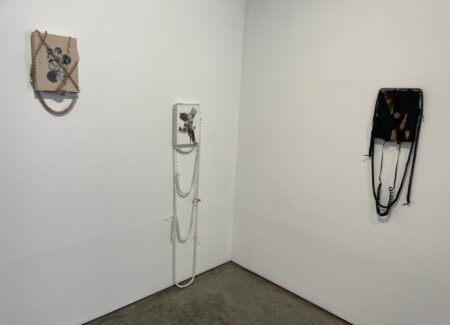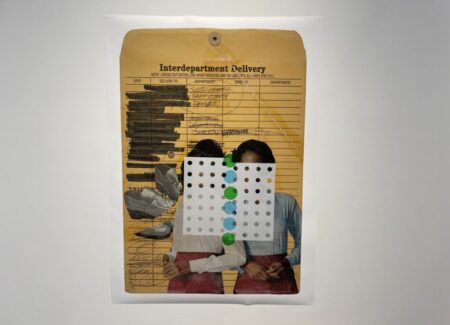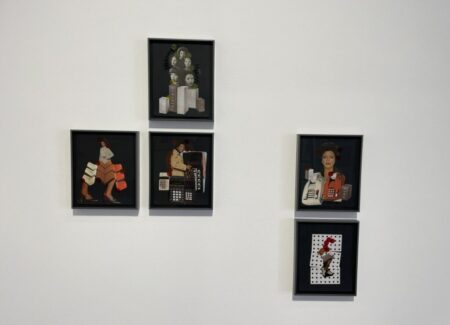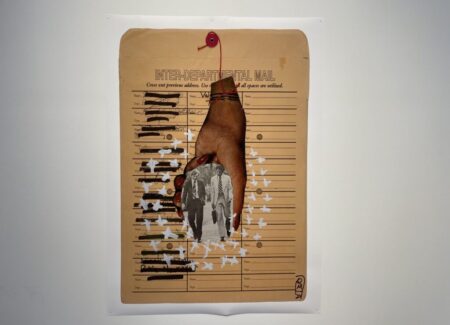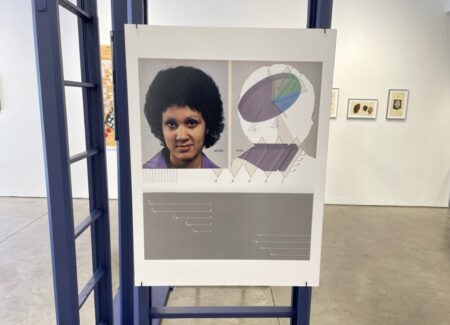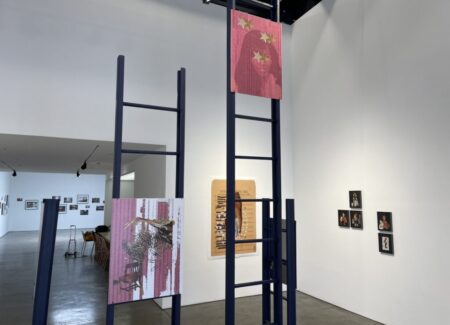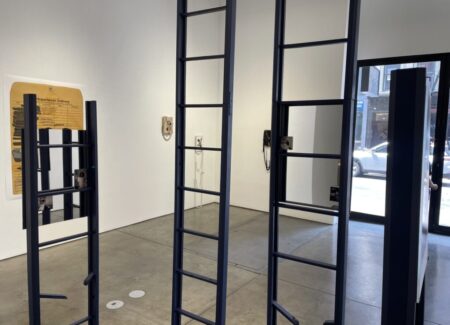JTF (just the facts): A total of 20 photographic works, displayed against white walls and on steel scaffolding, in the front gallery space. (Installation shots below.)
The following works are included in the show:
- 5 mixed media collages on vintage computer punch cards, 2023, 2025, sized roughly 7×13, 13×7, 20×11 inches
- 5 mixed media collages on black paper, 2023, 2024, sized 8×10 inches
- 3 archival inkjet prints, 2024, sized 40×60 inches
- 3 digital collage, archival inkjet print on mirrored Plexi, 2025, sized 16×24, 18×24 inches
- 1 archival inkjet print on mirrored Plexi, 2024, sized 18×24 inches
- 3 mixed media assemblages, 2024, 2025, sized 9×12 inches
Comments/Context: I’m old enough to remember what it was like in the pre-digital olden days to store papers in a three-ring binder. In terms of practicality, it was a decent solution – whatever papers you had to file away need only be passed through a mechanical three-hole puncher to then fit neatly into your binder (with was then further organized with color-coded or labeled dividers). But the one major drawback to this system was that if you pulled on the individual sheets a little too hard when they were in the binder, the holes in the paper might rupture, leading to sheets that were constantly getting misaligned or falling out, which was annoying. The simple remedy for this situation was the paper reinforcement – a white paper ring sticker that you could place over the torn hole to make it strong once again. The reinforcements were available in sheets of white labels sold at any office supply store, and it was good to have some handy, as this hole-tearing problem was pretty common.
As the resonant title of Qiana Mestrich’s show of recent photocollages, “The Reinforcements” provides multiple potential interpretations. Not only does it literally refer to the white labels, which she has physically used in several of her compositions, but it also evokes the military idea of “bringing in the reinforcements”, a support force of soldiers added to shore up an existing army. In the past few years, Mestrich’s artistic practice has revolved around exploring the history of black and immigrant women of color in the American corporate workplace, and the idea of those women being under seen and under appreciated “reinforcements” stands at the conceptual center of her new artworks. Using her own mother’s experiences, stories, and snapshots of her professional life as a starting point, Mestrich has assembled a digital archive of imagery (titled @WorkingWOC) documenting women of color in the workplace, spanning the mid 1960s to the early 2000s. This archive, both in what it shows and what is missing, has provided the inspiration and the visual raw material for a range of collage projects that Mestrich began in 2023.
Most of the collages in this show intermingle black faces and bodies from vintage fashion magazines with selected images from office supply catalogs, creating an expressively indirect portrait of the tasks and technologies of corporate clerical work. Set against enveloping black backgrounds, one group arranges the images into loose towers and triangles, with fashionable women (in tasteful suits and short haircuts) mixed with filing cabinets, adding machines, calculators, and arrays of office chairs. Red dot stickers and reinforcements tie things together, with both low heeled black pumps and white sneakers seen as practical footwear choices.
Another group of small collages uses outdated computer punch cards as their substrate, obliquely referring to the important role many black women played as computer operators in 20th century American offices. The largest of these creates a cruciform setup of briefcases (titled “A Stylish Accessory for Career Advancement”), with a black woman at the top and various dollar figures at the bottom. Other collages use the stickers as more graphic elements, building up colored lines and clouds, literally affixing black heads and faces to the underlying cards, with an old school paper Rolodex making an appearance.
The largest works in the show are enlarged images of smaller collages, featuring yellow interoffice envelopes as their physical foundation. In an age before email, these envelopes were the communications network of an office, being passed around from desk to desk, with names scratched off the front when the envelope was delivered. Mestrich’s collages interrupt that function, with more intermingled bodies and office equipment, once again using the stickers and marks in White-Out liquid (once used to fix typos on typed pages) to divide, decorate, and obscure her constructions. In one case, she uses the red string used to close the envelope like a hanging noose, with a black woman’s hand encircled by white crosses dangling below.
In the center of the gallery space, Mestrich has extended her ideas further into three dimensions. Black metal ladders, some with broken rungs, provide the scaffolding for displaying several other enlarged collages, while also metaphorically alluding to the progression of a career ladder and how difficult it was for black women to climb up that ladder. Mestrich’s collages mix various oblique business charts and graphs with gold stars, a box of Sphinx-branded business paper, and an arrangement of paper clips, a desk chair, and an elegant hand coming out from a golden sleeve. The backs of these works are mirrored, bringing layers of reflection into the experience, while also allowing the viewer to more easily enter the world of the works; tucked into their sides are a few vintage snapshots of black women at work, like physical artifacts or talismans of a bygone age. Nearby, three more sculptural works use the draped and twisting cords of old office telephones to further embellish Mestrich’s collaged imagery.
At a time when corporate diversity initiatives are being rolled back in America, Mestrich’s works feel like an intentional corrective, or at least a more active acknowledgment and recognition of the many contributions of black women in corporate roles in the past. Her collages intervene and reimagine the historical archive, paying attention to valuable workers that were consistently overlooked and undervalued. Her strongest compositions blend black style with throwback visual allusion, rethinking how these black women could and should have been seen. In this way, Mestrich’s collages are expressions of visibility, re-inserting black women back into a historical narrative that has largely erased them.
Collector’s POV: The works in this show are priced between $800 and $1800. Mestrich’s work has little secondary market history at this point, so gallery retail likely remains the best option for those collectors interested in following up.
